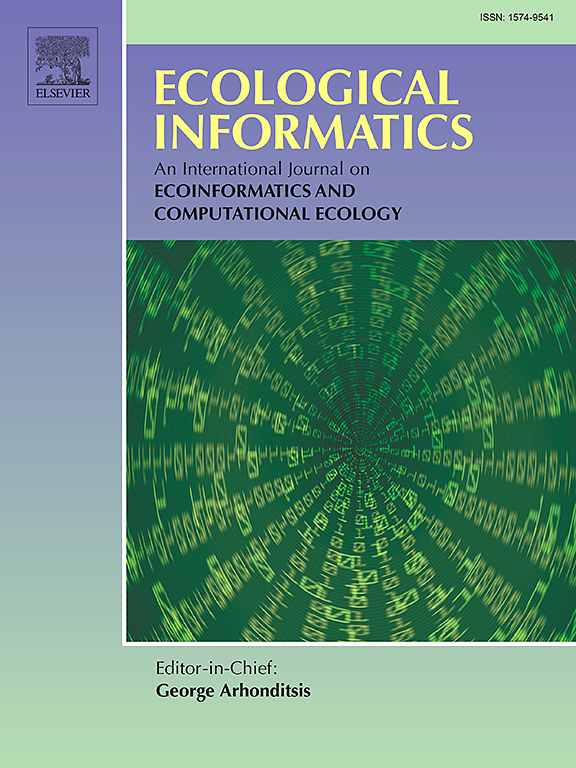Reconstructing daytime and nighttime MODIS land surface temperature in desert areas using multi-channel singular spectrum analysis
IF 5.8
2区 环境科学与生态学
Q1 ECOLOGY
引用次数: 0
Abstract
The availability of continuous spatiotemporal land surface temperature (LST) with high resolution is critical for many disciplines including hydrology, meteorology, ecology, and geology. Like other remote sensing data, satellite–based LST is also encountered with the cloud issue. In this research, over 5000 daytime and nighttime MODIS–LST images are utilized during 2014–2020 for Yazd–Ardakan plain in Yazd, Iran. The multi–channel singular spectrum analysis (MSSA) model is employed to reconstruct missing values due to dusts, clouds, and sensor defect. The selection of eigenvalues is based on the Monte Carlo test and the spectral analysis of eigenvalues. It is found that enlarging the window size has no effect on the number of significant components of the signal which account for the most variance of the data. However, data variance changes for all the three components. Employing two images per day, window sizes 60, 180, 360, and 720 are examined for reconstructing one year LST, where these selections are based on monthly, seasonal, semi-annual, and annual LST cycles, respectively. The results show that window size 60 had the least computational cost and the highest accuracy with RMSE (root mean square error) of 2.6 °C for the entire study region and 1.4 °C for a selected pixel. The gap–filling performance of MSSA is also compared with the one by the harmonic analysis of time series (HANTS) model, showing the superiority of MSSA with an improved RMSE of about 2.7 °C for the study region. In addition, daytime and nighttime LST series for different land covers are compared. Lastly, the maximum, minimum, and average LST for each day and night as well as average and standard deviation of LST images in the seven-year-long time series are also computed.
利用多通道奇异光谱分析重建沙漠地区昼夜 MODIS 陆面温度
提供高分辨率的连续时空陆地表面温度(LST)对水文学、气象学、生态学和地质学等许多学科都至关重要。与其他遥感数据一样,基于卫星的 LST 也会遇到云问题。本研究利用了 2014-2020 年间伊朗亚兹德地区亚兹德-阿尔达坎平原的 5000 多幅白天和夜间 MODIS-LST 图像。采用多通道奇异频谱分析(MSSA)模型来重建由于灰尘、云层和传感器缺陷造成的缺失值。特征值的选择基于蒙特卡罗测试和特征值频谱分析。结果发现,扩大窗口大小对信号的重要分量数量没有影响,而重要分量占数据方差的最大部分。然而,所有三个分量的数据方差都会发生变化。采用每天两幅图像、窗口大小 60、180、360 和 720 来重建一年的 LST,这些选择分别基于月、季节、半年和一年的 LST 周期。结果表明,窗口大小 60 的计算成本最低,精度最高,整个研究区域的 RMSE(均方根误差)为 2.6 ℃,选定像素的 RMSE 为 1.4 ℃。此外,还将 MSSA 与时间序列谐波分析(HANTS)模型的填隙性能进行了比较,结果表明 MSSA 的填隙性能更优越,对研究区域的均方根误差提高了约 2.7 ℃。此外,还比较了不同土地覆被的白天和夜间 LST 序列。最后,还计算了长达七年的时间序列中每昼夜的最大、最小和平均 LST,以及 LST 图像的平均值和标准偏差。
本文章由计算机程序翻译,如有差异,请以英文原文为准。
求助全文
约1分钟内获得全文
求助全文
来源期刊

Ecological Informatics
环境科学-生态学
CiteScore
8.30
自引率
11.80%
发文量
346
审稿时长
46 days
期刊介绍:
The journal Ecological Informatics is devoted to the publication of high quality, peer-reviewed articles on all aspects of computational ecology, data science and biogeography. The scope of the journal takes into account the data-intensive nature of ecology, the growing capacity of information technology to access, harness and leverage complex data as well as the critical need for informing sustainable management in view of global environmental and climate change.
The nature of the journal is interdisciplinary at the crossover between ecology and informatics. It focuses on novel concepts and techniques for image- and genome-based monitoring and interpretation, sensor- and multimedia-based data acquisition, internet-based data archiving and sharing, data assimilation, modelling and prediction of ecological data.
 求助内容:
求助内容: 应助结果提醒方式:
应助结果提醒方式:


